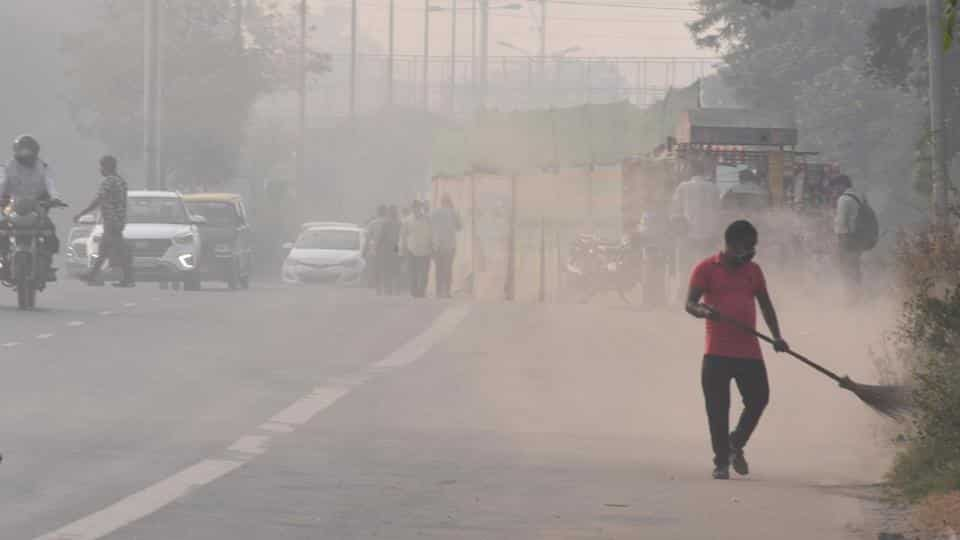
air quality is deteriorating, touching the “severe category” in various parts of Delhi-NCR. Still, there doesn’t seem to be any respite due to meteorological factors like wind speed and dipping air turning northwesterly, which contributes in non- dispersal of pollutants
Like every year, the air quality is deteriorating, touching the “severe category” in various parts of Delhi-NCR. Still, there doesn’t seem to be any respite due to meteorological factors like wind speed and dipping air turning northwesterly, which contributes in the non-dispersal of pollutants. With the temperature going down and Diwali approaching, air pollution seems to be the biggest concern in Delhi.
Meanwhile, the Union government introduced a new ordinance on 28th October to tackle air pollution. This came after the petition in SC by student Aditya Dubey that demanded a ban on stubble burning. The ordinance signed by the president dissolves the Environment Pollution (Prevention and Control) Authority for the National Capital Region (EPCA) and provides for constitution of a Permanent Commission for Air Quality Management (CAQM).
Earlier, Solicitor General Tushar Mehta had shown the intent of the government in the SC to introduce a permanent bill bringing all the stakeholders in a body to tackle air pollution. One of the key features of the body is that it can not only issue advisories but can also impose fines, therefore it’s a body with teeth. The ordinance provided five years of jail term and upto Rs 1 crores fine for violations of norms set by this body with immediate effect.
The ordinance says that it will be enforced in “adjoining areas” meaning the states of Punjab, Haryana, Rajasthan and Uttar Pradesh adjoining the National Capital Region of Delhi where the source of pollution is located.
The selection committee for CAQM — Union environment minister Prakash Javadekar, road transport and highways minister Nitin Gadkari, science and technology minister Harsh Vardhan, commerce minister Piyush Goyal, and cabinet secretary Rajiv Gauba are to pick six full-time members including the chairman of the commission.
This process will take time. The SC has already put in abeyance a one-member panel to monitor stubble burning after the government showed its intent.
Various NGOs and experts welcomed this step but many also questioned the non-representation of states and farmers in the panel. Yogendra Yadav, the political activist, tweeted that the commission doesn’t have farmers representation, though they are one of the main stakeholders. He also said the commission will bypass states.
Ritwik Dutta, an environment lawyer, wrote in an article for Carbancopy, that the power conferred on the new body already existed with it. “EPCA in its 22 years of existence has rarely exercised its statutory powers and has become an advisory body to the Supreme Court. The same situation is likely to take place with regard to the new Commission. Section 12 gives powers to entertain complaints. Such power already existed with EPCA, but was never exercised. The same is likely to continue with the new Commission,” he wrote.
Another concern that experts raised was the fines that the body can impose. The ordinance says that it can impose fine upto Rs 1 crore, depending on the damage.
Meanwhile, the Delhi-based non-profit, Centre for Chronic Disease Control (CCDC) prepared a report on the functioning of state pollution control boards. CCDC conducted interviews with officials at pollution control boards, bureaucrats, academics and environmentalists across eight cities–Lucknow, Patna, Ranchi, Raipur, Bhubaneswar, Vijayawada, Goa and Mumbai and prepared a report to determine what are the reasons for the failure of environmental boards.
As per a 2018 report by Greenpeace, 15 cities were included in 20 most polluted cities of the world. For that reason, it is important to see how the local bodies tasked with monitoring pollution are performing.
CCDC found that state pollution control boards are reeling under problems of non-payment of salaries, vacant seats, misinformation, lack of expertise and domain knowledge among members.
In that scenario, limited jurisdiction of the new ordinance in Delhi and “adjoining area” only takes a Delhi-centric view, despite having several other cities equally polluted.
(Cover: There seems to be no relief from the deteriorating air quality in various parts of Delhi-NCR, due to meteorological, which contribute the in non-dispersal of pollutants Photo: Twitter)
Police said despite sustained efforts, the accused remained at large and kept changing locations and…
At a debut solo exhibition in Delhi, an architect-artist explores sand, memory and movement through…
Om Taneja (81) and his wife Indira (77), a doctor, were kept under “digital arrest”…
The court observed although appellant had caused death by rash and negligent act, sending him…
AAP leaders were detained during a protest against the BJP over an alleged doctored video…
NDMC is rolling out a G20-style upgrade of roads, lighting and cleanliness to prepare Delhi…